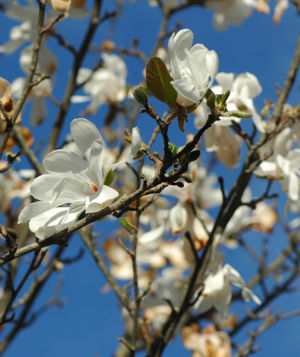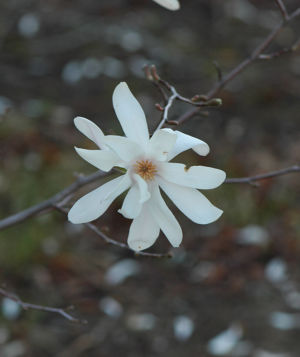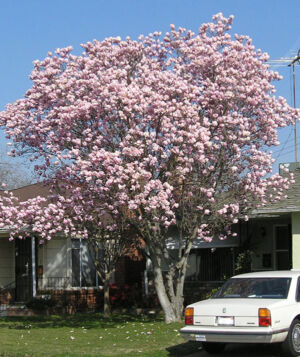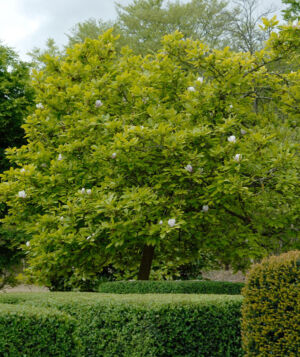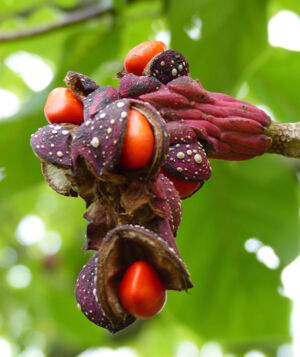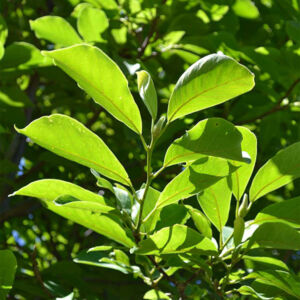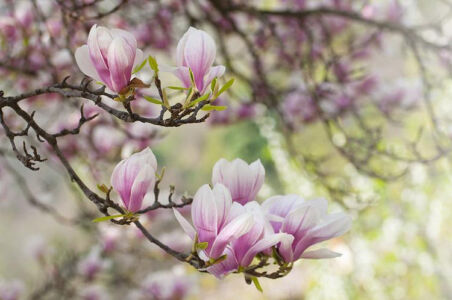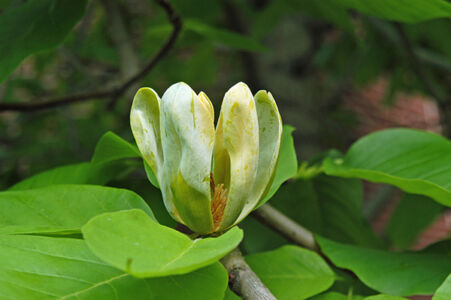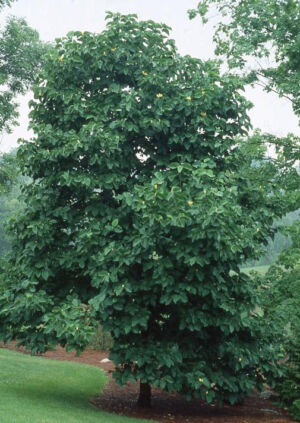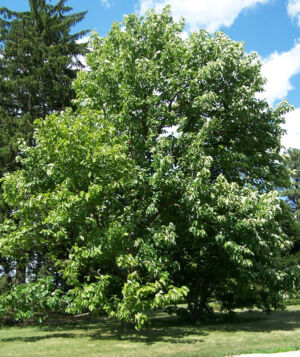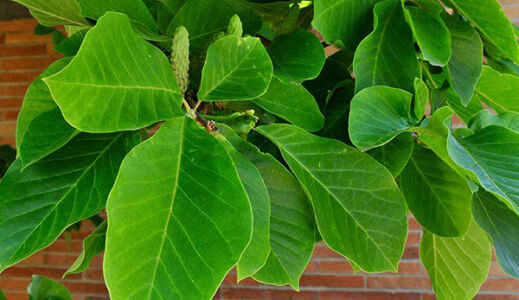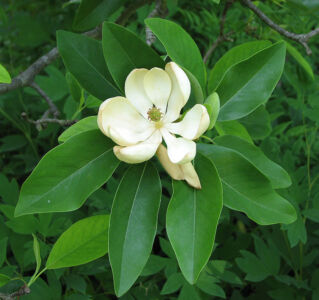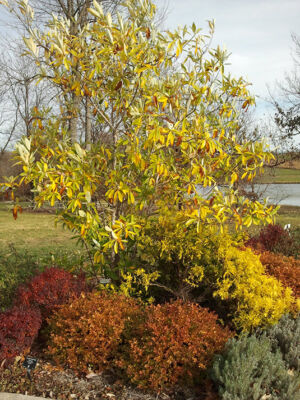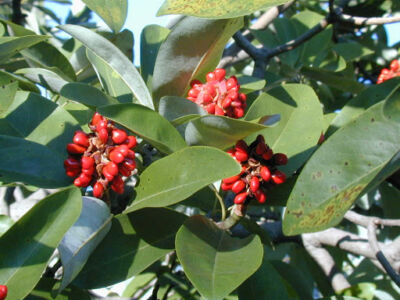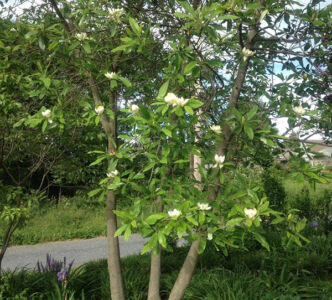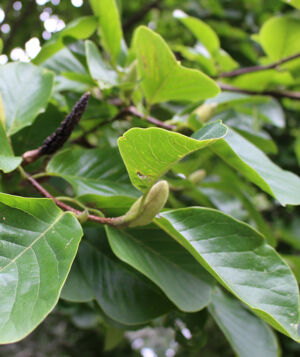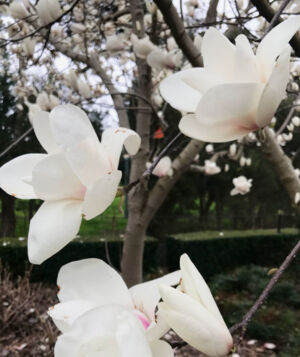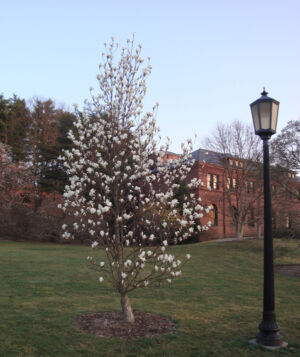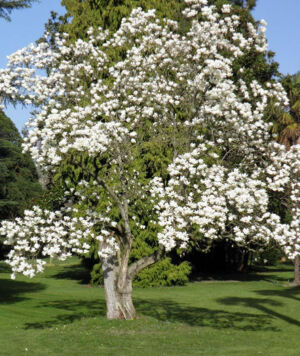Star Magnolia – Magnolia stellata
Description
General: Native to Japan, M. stellata is a small, slow growing, densely rounded tree that will grow 15-20′ in height, with a 10-15′ spread.
Leaves: Dark green elliptical turning yellowish in the fall. Densely foliated throughout the growing season. Buds are heavily pubescent.
Flowers: White, slightly fragrant flowers 3-4″ in diameter. Petals are 1.5-2″ long. One of the first magnolias to bloom in the spring. Average bloom time at Great Hill is April 19-28.
Fruit: Reddish-green, knotty aggregate fruit that matures in autumn.
Bark: Smooth gray bark throughout its life.
Attributes: A very showy spring flowering tree that maintains a tight compact branching habit throughout its life, Magnolia stellata is a wonderful specimen choice for many landscapes. Can be utilized to fit into tight or narrow spots where other trees or shrubs may out grow the site as well as be utilized as a deciduous privacy screen due to its dense summer foliage.
Culture
Hardiness: Zones 4- 8
Growing Conditions: Full sun for best flowering, but will withstand partial shade. Will grow best in moist, organic, fertile soil.
Maintenance: Low maintenance with little pruning needed. Magnolia Scale can be a problem if the tree is stressed or if there are not enough beneficial insects to keep populations in check. No real disease problems to report. Spring frosts may damage flower buds and can cause browning of flowers.
Transplanting: Spring dig only. Due to the structure of the roots (i.e. few lateral roots and fine root hairs) magnolias do not take well to transplanting. Regular deep watering should be performed to ensure that the roots do not dry out. Trees may take a few seasons to fully recover from transplanting.
Our Experience
Experience at Great Hill
Overall, we have had good success growing several different cultivars of M. stellata as well as the straight species.
Historical Winter Data:
2018:
Saucer Magnolia – Magnolia soulangeana
Description
General: An upright tree or multi-stemmed large spreading shrub that’s pyramidal in youth but rounded with age. Grows 20-30’ in height with similar spread.
Leaves: Alternate and simple 3-6” long, obovate. Dark flat green in the summer turning a yellow brown in the fall.
Flowers: 5 to 10” flowers from March to April before the leaves emerge that are white, pink or purple shades on the outside and shades of whitish pink inside. Susceptible to frost injury.
Fruit: A 4” long aggregate of follicles from August to September, reddish purple.
Bark: Gray. Smooth.
Attributes: Great when used as a small specimen tree. Can also be used in groupings or as a lawn tree.
Culture
Hardiness: Zones 4-9.
Growing Conditions: Prefers moist, deep acidic soil and full sun to light shade.
Maintenance: Mildew, leaf blights, canker and scale. If pruning is necessary, its best to prune directly after flowering so next years buds aren’t removed. Magnolias tend to aggressively sucker post pruning.
Transplanting: Magnolias have a fleshy root system with minimal lateral roots and root hairs. As such great care should be taken when transplanting to ensure soil is moist and amended with peat moss or leaf mold.
Our Experience
Experience at Great Hill
We have several soulangeana both on great hill and throughout the nursery. While susceptible to frosts, we’ve found that these trees are only completely at a loss one out of five years with maybe two of five partially frost bitten. The long lasting, fragrant, showy blooms along with habit make it an eye-catching specimen for any landscape.
Cucumber Magnolia – Magnolia acuminata
Description
General: Pyramidal when young, maturing to a broad rounded tree with massive spreading branches. Grows 50-80’.
Leaves: Alternate and simple 4-10” long. Dark green in the summer with an ashy brown fall color.
Bark: Smooth gray brown becoming ridged and furrowed with age.
Flowers: Greenish yellow petals 2 to 3” long in two sets of three. Slightly fragrant and often sit high in the tree. May to June, following leaf emergence.
Fruit: Warty and cucumber like, 2 to 3” long, pinkish red and maturing in October.
Attributes: Used for large areas, parks, estates, golf courses and naturalized areas.
Culture
Hardiness: Zones 3-8.
Growing Conditions: Perfers moist, organically rich, well drained loams in full sun. Does not tolerate drought or pollution.
Maintenance: No serious issues with insects or diseases. Can get magnolia scale.
Transplanting: Trees have fleshy roots without root hairs making transplanting difficult. Great care must be taken to be sure the tree is transplanted in the early spring to a location where cultural needs will be met.
Our Experience
Experience at Great Hill
We do not feature our cucumber magnolia on the landscape but have several in our nursery. These trees are large, impressive, and outstandingly beautiful when in bloom. Trees can take up to 12 years to bloom and grow at a fast rate. Great care must be taken to ensure proper placement in order for specimens to thrive.
Sweetbay Magnolia – Magnolia virginiana
Description
General: Small, multi-stemmed shrub that’s deciduous in the north and semi evergreen to evergreen in the south. Grows to 20’ in the north and upwards of 60’ in southern states.
Leaves: Alternate and simple, 3 to 5” long. Glossy dark green color on top and silver underneath. Turns yellow in the fall.
Flowers: Creamy white, lemon scented and 2 to 3” in diameter. Flowers have 9 to 12 petals and bloom from May to June and then sporadically until September.
Fruit: Cone like fruits up to 2” long with bright red seeds, maturing in August.
Attributes: Specimen tree for lawn or patio. Used in naturalized settings, foundation plantings, parks and wet areas.
Culture
Hardiness: Zones 5-9.
Growing Conditions: Prefers moist, even swampy, acidic soil in full sun to part shade.
Maintenance: No serious issues with insects or diseases. Chlorosis can occur if soil conditions aren’t met.
Transplanting: Like all magnolias, roots are fleshy with few lateral roots or root hairs making transplanting difficult. Care must be taken to meet cultural requirements.
Our Experience
Experience at Great Hill
Our sweetbay magnolia is featured in our scented garden. Its perfect for this small area adding a lovely lemon fragrance when it blooms late spring/early summer. Our scented garden is also in a sheltered area that’s kept moist by partial shade, as such the conditions are optimal for our specimen.
Yulan Magnolia – Magnolia denudata
Description
General: Small, pyramidal to rounded tree growing 30 to 40′ in height and spread.
Leaves: Alternate, simple and obovate 4 to 6″ long. Dark green.
Flowers: Lily turning goblet shaped, 5 to 6″ across. Petals are white often with a pink base, lemon scented and can be injured by late season freezes.
Fruit: 4 to 6″ long cylindrical aggregates turning rose red as the season progresses.
Attributes: Spectacular early flowering magnolia used as a specimen tree.
Culture
Hardiness: Zones 5-8
Growing Conditions: Prefers moist, well drained soils in full sun to part shade.
Maintenance: No serious issues with insects or diseases.
Transplanting: Like all magnolias, roots are fleshy with few lateral roots or root hairs making transplanting difficult. As far as propagation, Magnolia denudata is often budded and grafted onto Magnolia soulangeana.
Our Experience
Experience at Great Hill
We have several large yulan magnolia growing in our nursery fields on great hill. It’s an attractive and hardy magnolia and is the parent tree to several magnolia crosses specifically x soulangeana and x veitchii. The benefit of crossing this magnolia is the resulting later bloom. In our zone, denudatas early flowers are often killed by late frost.
2023
Magnolia Bloom Data 2023
| Plant Name | Bud Break | Full Bloom | Bloom Drop |
|---|---|---|---|
| stellata 'Rosea' | April 3 | April 16 | May 1 |
| stellata 'Centennial' | April 3 | April 13 | May 5 |
| x loebneri 'Merrill' | April 3 | April 14 | May 5 |
| x loebneri 'Leonard Messel' | April 8 | April 15 | May 5 |
| x loebneri 'Spring Snow' | April 3 | April 12 | May 3 |
| x soulangeana 'Alexandria' | April 12 | April 27 | May 12 |
| x soulangeana 'Rustica Rubra' | April 10 | April 24 | May 10 |
| denudata | April 4 | April 15 | April 28 |
| x 'Yellow Lantern' | April 3 | April 14 | May 5 |
| x 'Galaxy' | April 10 | April 26 | May 12 |
| x 'Sayonara' | April 2 | April 11 | April 25 |
| x 'Elizabeth' | April 14 | May 2 | May 16 |
| x 'Butterflies' | April 15 | May 2 | May 7 |
| liliiflora 'Ann' | April 10 | April 26 | May 15 |
| liliiflora 'Betty' | April 11 | April 30 | May 16 |
| virginiana | June 8 | June 19 | July 1 |
2022
Magnolia Bloom Data 2022
| Plant Name | Bud Break | Full Bloom | Bloom Drop |
|---|---|---|---|
| stellata 'Rosea' | April 5 | April 17 | May 5 |
| stellata 'Centennial' | March 31 | April 18 | May 2 |
| x loebneri 'Merrill' | April 6 | April 16 | April 27 |
| x loebneri 'Leonard Messel' | March 31 | April 18 | May 2 |
| x loebneri 'Spring Snow' | March 31 | April 18 | April 29 |
| x soulangeana 'Alexandria' | April 9 | April 27 | May 14 |
| x soulangeana 'Rustica Rubra' | April 8 | May 2 | May 12 |
| denudata | April 2 | April 16 | April 29 |
| x 'Yellow Lantern' | April 22 | May 6 | May 16 |
| x 'Galaxy' | April 18 | April 28 | May 12 |
| x 'Sayonara' | March 31 | April 18 | April 27 |
| x 'Elizabeth' | April 22 | May 6 | May 18 |
| x 'Butterflies' | April 18 | May 6 | May 11 |
| liliiflora 'Ann' | April 8 | May 2 | May 18 |
| liliiflora 'Betty' | April 8 | may 2 | May 18 |
| virginiana | June 3 | June 8 | July 1 |


